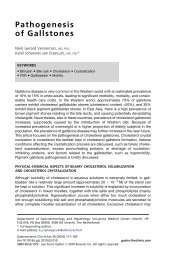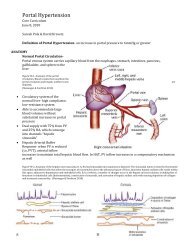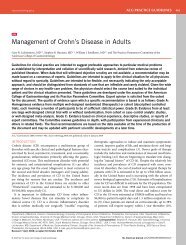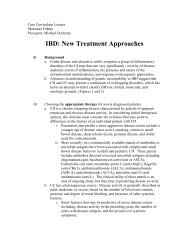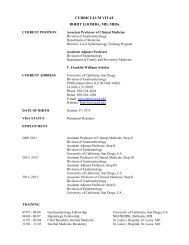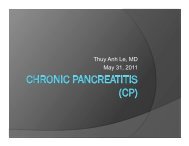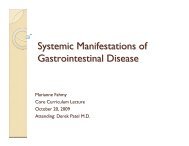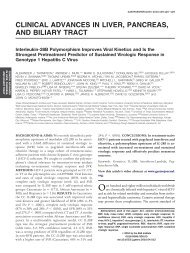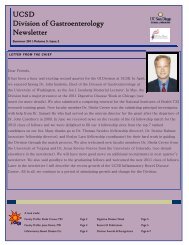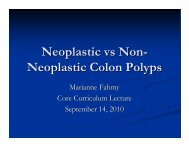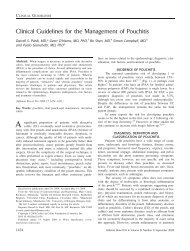<strong>Small</strong>-<strong>bowel</strong> <strong>imag<strong>in</strong>g</strong> <strong>in</strong> Crohn’s <strong>disease</strong>Solem et alTABLE 3. F<strong>in</strong>al overall cl<strong>in</strong>ical diagnosis (not limited tothe small <strong>in</strong>test<strong>in</strong>e) <strong>in</strong> all 41 patients who underwent atleast 1 diagnostic test, and <strong>in</strong> 26 patients whounderwent all 4 testsCl<strong>in</strong>icaldiagnosisAllpatients,n (%)*Patientswith all 4tests, n (%)yCrohn’s <strong>disease</strong> 30 (73%) 19 (73%)Indeterm<strong>in</strong>ate abdom<strong>in</strong>al pa<strong>in</strong> 3 (7%) 3 (11%)Irritable <strong>bowel</strong> syndrome 2 (5%) 2 (8%)Ulcerative colitis 1 (2%) 0 (0%)Indeterm<strong>in</strong>ate colitis 1 (2%) 0 (0%)Carc<strong>in</strong>oid 1 (2%) 0 (0%)Submucosal mass, small <strong>bowel</strong> 1 (2%) 1 (4%)Gastroparesis 1 (2%) 1 (4%)Indeterm<strong>in</strong>ate diarrhea 1 (2%) 0 (0%)Total 41 (100%) 26 (100%)*Percentage of the group undergo<strong>in</strong>g at least 1 SB <strong>imag<strong>in</strong>g</strong> test.yPercentage of the group undergo<strong>in</strong>g all 4 tests.the ileocolonoscopy and SBFT comb<strong>in</strong>ation. The specificityof exam<strong>in</strong>ation comb<strong>in</strong>ations aga<strong>in</strong>st the criterion standardranged from a high of 100% for SBFT plusileocolonoscopy to a low of 53% for both the CE plusSBFT and CE plus CTE comb<strong>in</strong>ations. The overall accuracyof exam<strong>in</strong>ation comb<strong>in</strong>ations aga<strong>in</strong>st the criterion standardranged from 89% for both the CTE plus ileocolonoscopyand CTE plus SBFT comb<strong>in</strong>ations to 70% for theCE plus CTE and CE plus SBFT comb<strong>in</strong>ations.No pair of SB exam<strong>in</strong>ations was significantly more sensitivethan the comb<strong>in</strong>ation conta<strong>in</strong><strong>in</strong>g the other two exam<strong>in</strong>ations(among the 4 SB exam<strong>in</strong>ations), P O .05(Table 6). However, each comb<strong>in</strong>ation of exam<strong>in</strong>ationsthat <strong>in</strong>cluded CE had a significantly lower specificity(57%) than did the opposite pair of exam<strong>in</strong>ations (P Z.03 for each of the 3 comparisons, unadjusted).Patients completed a questionnaire at the end of thestudy. All patients swallowed the capsule easily. N<strong>in</strong>etytwopercent of patients did not experience any pa<strong>in</strong> dur<strong>in</strong>gthe CE study, significantly better than colonoscopy(P ! .05), but no better than CTE or SBFT (P O .05).N<strong>in</strong>ety-three percent of patients stated they would undergoa CE study aga<strong>in</strong>, which was not significantly differentthan the other tests (P O .05).Even though all patients with obstructive symptomswere excluded from study enrollment, we detected anasymptomatic PSBO <strong>in</strong> 7 patients (17%) on CTE (Fig. 2),exclud<strong>in</strong>g them from CE. Soon after capsule <strong>in</strong>gestion,one patient with a very long segment of active <strong>disease</strong>but without PSBO on CTE (3.4%) experienced a highlysymptomatic PSBO requir<strong>in</strong>g hospitalization, but the capsulepassed with<strong>in</strong> a few days follow<strong>in</strong>g medical therapywith corticosteroids and <strong>in</strong>fliximab, with symptoms resolv<strong>in</strong>g(Fig. 3). Unlike the higher capsule retention rates seen<strong>in</strong> other studies, we had no reta<strong>in</strong>ed capsules (confirmedby radiograph) us<strong>in</strong>g our diagnostic algorithm.Chyme significantly limited study quality <strong>in</strong> 4 patientswho underwent CE (14%) despite efforts to cleanse with1 L PEG solution prior to the study. The term<strong>in</strong>al ileumwas exam<strong>in</strong>ed completely <strong>in</strong> only 75% of studies. One capsulestudy had a technical malfunction result<strong>in</strong>g <strong>in</strong> no images.In a s<strong>in</strong>gle patient with suspected Crohn’s <strong>disease</strong>,CE demonstrated multiple SB erosions when the other 3SB tests were normal (Fig. 4).DISCUSSIONIn this <strong>prospective</strong>, bl<strong>in</strong>ded trial, we compared 4 primarysmall-<strong>in</strong>test<strong>in</strong>al <strong>imag<strong>in</strong>g</strong> modalities <strong>in</strong> the diagnosisof SB Crohn’s <strong>disease</strong>. In contrast to the other studies exam<strong>in</strong><strong>in</strong>gthe utility of CE <strong>in</strong> patients with known or suspectedCrohn’s <strong>disease</strong>, 22,27,29,33-40 we believe this is theonly <strong>prospective</strong>, bl<strong>in</strong>ded trial compar<strong>in</strong>g all 4 primarySB <strong>imag<strong>in</strong>g</strong> modalities over a short time period, avoid<strong>in</strong>gboth treatment and natural history effects. Unlike the ‘‘diagnosticyield’’ reported <strong>in</strong> most published CE studies, weestablished a surrogate criterion standard, allow<strong>in</strong>g us tocalculate the sensitivity, specificity, and accuracy of eachtest for diagnos<strong>in</strong>g SB Crohn’s <strong>disease</strong>. We found thatthere was no significant difference among CTE, CE, ileocolonoscopy,and SBFT for the sensitivity or accuracy of diagnos<strong>in</strong>gSB Crohn’s <strong>disease</strong>. CTE and CE demonstratedsimilarly high sensitivity for SB Crohn’s, which was numericallysuperior to SBFT and ileocolonoscopy. Although thenumerical superiority of CTE and CE was not statisticallysignificant, this may have been due to the limited samplesize and potential lack of power to detect a significant difference.Comb<strong>in</strong><strong>in</strong>g diagnostic tests may improve sensitivity,and this is commonly used <strong>in</strong> cl<strong>in</strong>ical practice. Wefound that the specificity of CE for SB Crohn’s <strong>disease</strong>was significantly lower than other SB <strong>imag<strong>in</strong>g</strong> modalities,which lowered its overall accuracy. Our study also <strong>in</strong>directlysuggests that SB radiologic <strong>imag<strong>in</strong>g</strong> may be neededprior to CE <strong>in</strong> suspected or known Crohn’s <strong>disease</strong> patients,due to the high frequency (17%) of asymptomaticPSBO. When we used an algorithm of perform<strong>in</strong>g CTEprior to CE and us<strong>in</strong>g a f<strong>in</strong>d<strong>in</strong>g of stricture with proximal<strong>bowel</strong> dilation to preclude <strong>in</strong>gestion of the endoscopycapsule, we observed no capsule retention.The f<strong>in</strong>d<strong>in</strong>g of a lower specificity of CE for SB Crohn’s<strong>disease</strong> is not entirely unexpected. ‘‘Diagnostic yield’’ asa measure of the operat<strong>in</strong>g performance of a diagnostictest is less than idealdit merely reports the prevalenceof abnormalities detected by a particular <strong>imag<strong>in</strong>g</strong> modalityand does not attempt to determ<strong>in</strong>e whether those260 GASTROINTESTINAL ENDOSCOPY Volume 68, No. 2 : 2008 www.giejournal.org
Solem et al<strong>Small</strong>-<strong>bowel</strong> <strong>imag<strong>in</strong>g</strong> <strong>in</strong> Crohn’s <strong>disease</strong>TABLE 4. Individual performance estimates of 4 diagnostic tests and all pairs of these tests for active small-<strong>bowel</strong> Crohn’s <strong>disease</strong>*SB test Patients tested, n Sensitivity (%) 95% CI Specificity (%) 95% CI Accuracy (%) 95% CIIndividual testCE 27 10/12 (83) 52-98 8/15 (53) 27-79 18/27 (67) 46-83CTE 41 18/22 (82) 60-95 17/19 (89) 67-99 35/41 (85) 71-94Ileocolonoscopy 36 14/19 (74) 49-91 17/17 (100) 80-100 31/36 (86) 71-95SBFT 38 13/20 (65) 41-8 17/18 (94) 73-100 30/38 (79) 63-90Pairs of TestsCE & CTE 27 11/12 (92) 62-100 8/15 (53) 27-79 19/27 (70) 50-86CE & ileocolonoscopy 26 12/12 (100) 74-100 8/14 (57) 29-82 20/26 (77) 56-91CE & SBFT 27 11/12 (92) 62-100 8/15 (53) 27-79 19/27 (70) 50-86SBFT & ileocolonoscopy 34 14/18 (78) 52-94 16/16 (100) 79-100 30/34 (88) 73-97CTE & ileocolonoscopy 36 16/19 (84) 60-97 16/17 (94) 71-100 32/36 (89) 74-97CTE & SBFT 38 17/20 (85) 62-97 17/18 (94) 73-100 34/38 (89) 75-97CTE, CT enterography; CE, capsule endoscopy; SBFT, small-<strong>bowel</strong> follow-through; 95% CI, 95% confidence <strong>in</strong>tervals.*Criterion standard is based on consensus diagnosis of active Crohn’s <strong>disease</strong> or suspicious for Crohn’s <strong>disease</strong>.TABLE 5. Comparison of sensitivity and specificitybetween capsule endoscopy and 3 other diagnostictests for active small-<strong>bowel</strong> Crohn’s <strong>disease</strong>*SB testSensitivity(%)P-valueySpecificity(%)P-valueyCE 10/12 (83) ref 8/15 (53) refCTE 8/12 (67) .63 15/15 (100) .02Ileocolonoscopy 8/12 (67) .69 14/14 (100) .03SBFT 6/12 (50) .22 15/15 (100) .02CTE, CT enterography; CE, capsule endoscopy; SBFT, small-<strong>bowel</strong>follow-through; 95% CI, 95% confidence <strong>in</strong>tervals.*Criterion standard is based on consensus diagnosis of activeCrohn’s <strong>disease</strong> or suspicious for Crohn’s <strong>disease</strong>.yUs<strong>in</strong>g Mc Nemar’s test for paired proportions, test<strong>in</strong>g performancecompared to the CE exam<strong>in</strong>ation, unadjusted for multiplecomparisons.abnormal f<strong>in</strong>d<strong>in</strong>gs are cl<strong>in</strong>ically significant. Most studiesreport<strong>in</strong>g ‘‘diagnostic yield’’ do so because the test isnot be<strong>in</strong>g compared aga<strong>in</strong>st a reference standard. CE isan extremely sensitive tool for direct visualization ofthe SB mucosa. As <strong>in</strong> most diagnostic tests, improvedsensitivity typically comes at the cost of decreased specificity.43 Goldste<strong>in</strong> et al 44 found that 22% of asymptomaticcontrol patients who denied recent NSAID <strong>in</strong>gestion hadSB abnormalities at CE, with an average of 4 lesions persubject. As several CE f<strong>in</strong>d<strong>in</strong>gs, such as mucosal erythema,are nonspecific, and do not <strong>in</strong>dicate a diagnosisof active Crohn’s <strong>disease</strong> by themselves, their <strong>in</strong>clusionTABLE 6. Selected comparisons of sensitivity andspecificity between pairs of small-<strong>bowel</strong> exam<strong>in</strong>ations*CE &ileocolonoscopySensitivity(%)P- Specificityvaluey (%)12/12 (100) 8/14 (57)P-valueyCTE & SBFT 9/12 (75) .25 14/14 (100) .03CE & CTE 11/12 (92) 8/14 (57)SBFT &ileocolonoscopy9/12 (75) .63 14/14 (100) .03CE & SBFT 11/12 (92) 8/14 (57)CTE &ileocolonoscopy9/12 (75) .63 14/14 (100) .03CTE, CT enterography; CE, capsule endoscopy; SBFT, small-<strong>bowel</strong>follow-through; 95% CI, 95% confidence <strong>in</strong>tervals.*Criterion standard is based on consensus diagnosis of activeCrohn’s <strong>disease</strong> or suspicious for Crohn’s <strong>disease</strong>.yUs<strong>in</strong>g McNemar’s test for paired proportions, unadjusted formultiple comparisons.<strong>in</strong>to reference standard assessments of <strong>disease</strong> activity<strong>in</strong> SB <strong>imag<strong>in</strong>g</strong> trials may result <strong>in</strong> confirmation bias favor<strong>in</strong>gCE.Buchman et al 36 used SBFT as a method to detect SBstrictures that may lead to reta<strong>in</strong>ed capsules, and founda 29% <strong>in</strong>cidence of SB strictures <strong>in</strong> Crohn’s patients, whichprecluded capsule endoscopy. By us<strong>in</strong>g SBFT as a screen<strong>in</strong>gexam<strong>in</strong>ation, they observed 2 episodes of capsule retention(7%). Voderholzer et al 27 compared CE and CTEwww.giejournal.org Volume 68, No. 2 : 2008 GASTROINTESTINAL ENDOSCOPY 261



